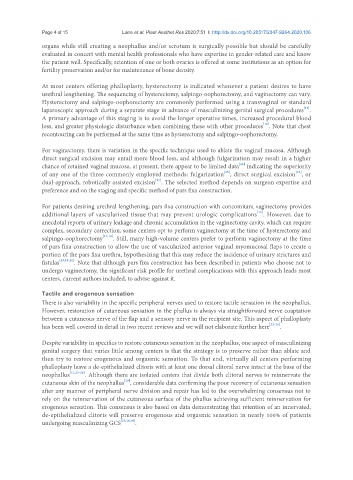Page 588 - Read Online
P. 588
Page 4 of 15 Lane et al. Plast Aesthet Res 2020;7:51 I http://dx.doi.org/10.20517/2347-9264.2020.106
organs while still creating a neophallus and/or scrotum is surgically possible but should be carefully
evaluated in concert with mental health professionals who have expertise in gender-related care and know
the patient well. Specifically, retention of one or both ovaries is offered at some institutions as an option for
fertility preservation and/or for maintenance of bone density.
At most centers offering phalloplasty, hysterectomy is indicated whenever a patient desires to have
urethral lengthening. The sequencing of hysterectomy, salpingo-oophorectomy, and vaginectomy can vary.
Hysterectomy and salpingo-oophorectomy are commonly performed using a transvaginal or standard
[13]
laparoscopic approach during a separate stage in advance of masculinizing genital surgical procedures .
A primary advantage of this staging is to avoid the longer operative times, increased procedural blood
[14]
loss, and greater physiologic disturbance when combining these with other procedures . Note that chest
recontouring can be performed at the same time as hysterectomy and salpingo-oophorectomy.
For vaginectomy, there is variation in the specific technique used to ablate the vaginal mucosa. Although
direct surgical excision may entail more blood loss, and although fulgarization may result in a higher
[14]
chance of retained vaginal mucosa, at present, there appear to be limited data indicating the superiority
[16]
[15]
of any one of the three commonly employed methods: fulgarization , direct surgical excision , or
dual-approach, robotically assisted excision . The selected method depends on surgeon expertise and
[17]
preference and on the staging and specific method of pars fixa construction.
For patients desiring urethral lengthening, pars fixa construction with concomitant vaginectomy provides
[15]
additional layers of vascularized tissue that may prevent urologic complications . However, due to
anecdotal reports of urinary leakage and chronic accumulation in the vaginectomy cavity, which can require
complex, secondary correction, some centers opt to perform vaginectomy at the time of hysterectomy and
salpingo-oophorectomy [17,18] . Still, many high-volume centers prefer to perform vaginectomy at the time
of pars fixa construction to allow the use of vascularized anterior vaginal myomucosal flaps to create a
portion of the pars fixa urethra, hypothesizing that this may reduce the incidence of urinary strictures and
fistulas [15,19-21] . Note that although pars fixa construction has been described in patients who choose not to
undergo vaginectomy, the significant risk profile for urethral complications with this approach leads most
centers, current authors included, to advise against it.
Tactile and erogenous sensation
There is also variability in the specific peripheral nerves used to restore tactile sensation in the neophallus.
However, restoration of cutaneous sensation in the phallus is always via straightforward nerve coaptation
between a cutaneous nerve of the flap and a sensory nerve in the recipient site. This aspect of phalloplasty
has been well covered in detail in two recent reviews and we will not elaborate further here [22-24] .
Despite variability in specifics to restore cutaneous sensation in the neophallus, one aspect of masculinizing
genital surgery that varies little among centers is that the strategy is to preserve rather than ablate and
then try to restore erogenous and orgasmic sensation. To that end, virtually all centers performing
phalloplasty leave a de-epithelialized clitoris with at least one dorsal clitoral nerve intact at the base of the
neophallus [11,25-28] . Although there are isolated centers that divide both clitoral nerves to reinnervate the
[29]
cutaneous skin of the neophallus , considerable data confirming the poor recovery of cutaneous sensation
after any manner of peripheral nerve division and repair has led to the overwhelming consensus not to
rely on the reinnervation of the cutaneous surface of the phallus achieving sufficient reinnervation for
erogenous sensation. This consensus is also based on data demonstrating that retention of an innervated,
de-epithelialized clitoris will preserve erogenous and orgasmic sensation in nearly 100% of patients
undergoing masculinizing GCS [25,26,30] .

